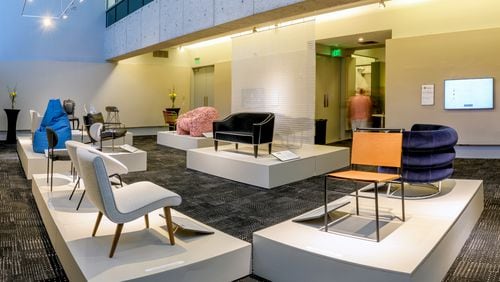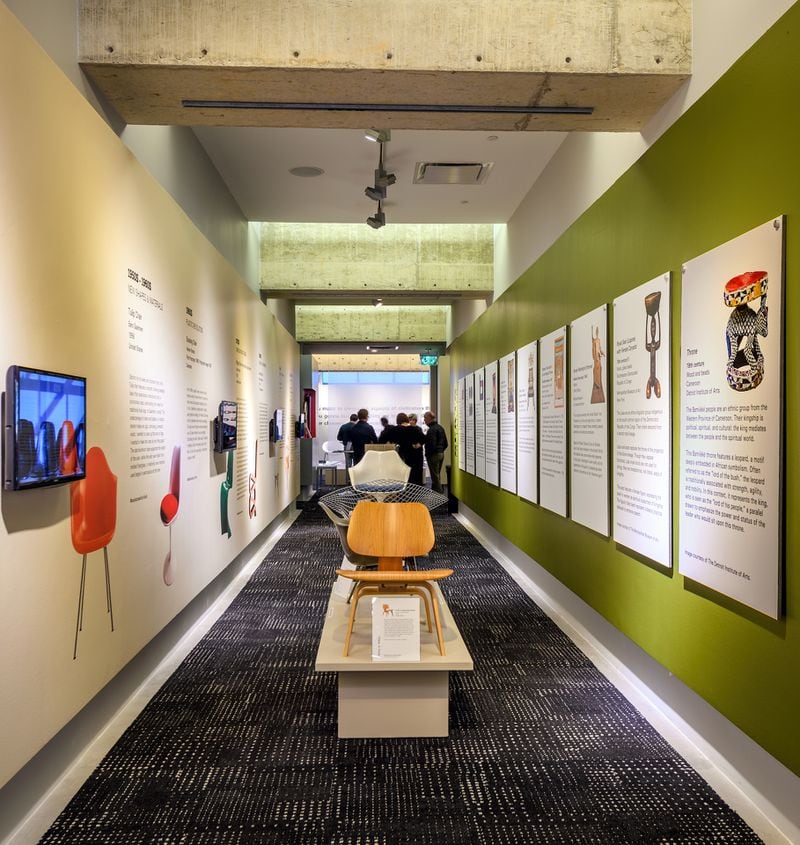This story was originally published by ArtsATL.
Chairs, settees, benches or mats — seats, in other words — are among the most quotidian of objects. It is natural for humans to fold their legs and place their rears in a parallel position to the ground. Consequently, the objects accommodating their bodies must be functional, providing stability and comfort.
Chairs are also human-scaled vessels to be designed and embellished, reflecting the creativity of their designers working within the taste and technological advancements of their eras. Now they are also the subject of Museum of Design Atlanta’s (MODA) current exhibition ”Please Be Seated: A Century of Chair Design.”
Primarily focusing on American and European design, “Please Be Seated” (through March 11) is several exhibitions in one. Part one is a primer on chair design of the last 150 years featuring photographs, videos and physical examples of iconic chairs, the majority of which are still in production. The exhibition makes the strong case that industrialization, driven by technological advancements and mass production developments, has been a foundation of modern design.
Credit: (Photo by Gene Phillips Photography)
Credit: (Photo by Gene Phillips Photography)
Most of these chairs are familiar and considered classics. Take for example the Thonet 214, a bentwood chair designed by cabinetmaker Michael Thonet in 1859 in Vienna and still considered the quintessential coffeehouse chair. Thonet’s innovation was a process for bending solid wood with steam, allowing curvilinear furniture to be mass-produced for the first time.
Or look at Ray and Charles Eames’ chair in molded fiberglass (a material developed during the World War II years). It was the first with a seat and backrest formed from a single shell and representative of the ingenuity of American designers. More current is Bits&Parts, a 3D printed chair designed by Joris Laarman of Laarman Lab in the Netherlands. You can download the files and print your own chair, if you are so inclined.
After being tutored about this history, the visitor is led to the main gallery with examples of 20th and 21st centuries high-end design. All uniquely elegant, these seating examples are mostly for the well-heeled — but can’t we dream?
Celebrating women designers, who have been historically undervalued, is Eileen Gray (1878-1976), born in Ireland and based in France. She is represented by her Bibendum lounge chair (1926) and Roquebrune dining chair (1932) that reference the minimalist design vocabulary of the Art Deco era. She designed sophisticatedly simple seating that used tubular steel — cutting edge material of her day — and beautifully crafted upholstery.
A personal favorite and available at a relatively reasonable price is Philippe Starck’s 2002 Louis Ghost Chair, originally made of Lucite and now produced of polycarbonate material. Echoing a Louis XIV armchair, Starck’s chair reminds us how design is constantly responding and recycling the past, as well as affirming that great design can be accessible.
Credit: Courtesy of Museum of Design Atlanta
Credit: Courtesy of Museum of Design Atlanta
Not as readily available to the regular person is the fantastical Hortensia Lounge Chair, designed by Andrés Reisinger and Júlia Esqué for Moooi, based in the Netherlands. Originally crafted as an NFT by Reisinger, the Hortensia (hydrangea in Spanish) is a fairyland chair made of thousands of pink fabric petals. Branding “Please Take a Seat,” the Hortensia is truly a chair of the 21st century, blending the digital and physical worlds.
Part two of the exhibition explores the historic power dynamics and social significance of chairs. Lining the hallway across from the iconic timeline of modernist chairs are panels with photos and texts devoted to “Seats of Power,” from King Tutankhamun’s throne to the jaguar throne of El Castillo from Chichén Itzá in the Yucatan, and an image of Black Panther Huey Newton seated in the iconic peacock chair.
The panels make their point: Thrones (by definition elaborate and linked to power) have historic significance that extends beyond their intrinsic beauty. Limited by space constraints, this section could have been enhanced with a deeper social history dive.
“Seats of Power” is a lead-in to the side gallery, which MODA typically uses to make its exhibitions relevant to Atlanta and young audiences. Rifting off Congresswoman Shirley Chisholm’s famous adage — “if they don’t give you a seat at the table, bring a folding chair” — MODA invited Atlanta-based artists to embellish folding chairs from perhaps the most democratic of stores, IKEA.
The socially relevant results include Jamaal Barber’s Chair for the Ancestors and Kristen Woolford’s feminist Chair for Women in Technology, Engineering and Gaming. The museum provides visitors, including kids, with paper templates and plenty of pens and invites us to sit at tables and make our own “power” chairs.
Rounding out the professional artists’ contributions are three-legged stools created by community-based organizations such as the Jolly Avenue Garden, a community gathering space in Clarkston. Its stool is dedicated to people impacted by food insecurity. None of this, including the folding chairs, is great art, but the gesture toward inclusivity is appreciated and certainly is a contrast to the high design concepts featured in the exhibition’s first section.
“Please Be Seated” is an entertaining exhibition with an excellent recap of iconic seating from the 19th to 21st centuries and an opportunity to see cutting-edge contemporary chairs. Its contrasting auxiliary “power” chairs section provides a social justice spin that allows for community engagement — always welcomed in a museum setting.
ART REVIEW
“Please Be Seated”
Through March 11 at Museum of Design Atlanta. Noon-7 p.m. Wednesdays-Sundays. $10; $8 seniors, students, teachers, military; free for ages 11 and under. 1315 Peachtree St. N.E. 404-979-6455, www.museumofdesign.org.
::
Louise E. Shaw has been a cultural worker in Atlanta for over 40 years. She served as executive director of Nexus Contemporary Art Center from 1983 to 1998 and was on Eyedrum’s ad hoc advisory board in the 2000s.
Credit: ArtsATL
Credit: ArtsATL
MEET OUR PARTNER
ArtsATL (www.artsatl.org), is a nonprofit organization that plays a critical role in educating and informing audiences about metro Atlanta’s arts and culture. Founded in 2009, ArtsATL’s goal is to help build a sustainable arts community contributing to the economic and cultural health of the city.If you have any questions about this partnership or others, please contact Senior Manager of Partnerships Nicole Williams at nicole.williams@ajc.com.









